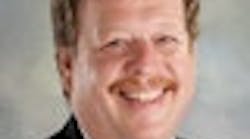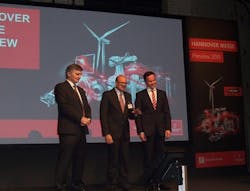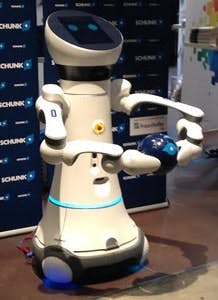This year's version of the world's largest manufacturing exhibition will be held April 13-17 in its usual 26 halls in Hannover, but organizers and more than 40 exhibitors provided a comprehensive sneak peak of the fair's Industry 4.0 and related solutions on Feb.3 at the ewerk hall and former power plant substation in Berlin. Organizers expect the fair to top the 6,400 exhibitors it hosted two years ago. They'll also be joined by India as the event's 2015 partner country, which will feature its new "Make in India" program to make it easier for manufacturers to do business there.
Dr. Jochen Koeckler, member of Duetsche Messe AG's managing board, reports his organization queried manufacturers if they're ready for Industry 4.0 or the 4th Industrial Revolution, and the answer is almost always "no." "Research shows 50% of those in manufacturing never heard of Industry 4.0, and 25% have heard of it, but don't know what it's about," said Koeckler. "So, the message is that we need to be prepared because another recent study found that an 18% increase in efficiency and a 15% increase in savings will be possible over the next five years thanks to the productivity enabled by Industry 4.0."
To achieve these gains, Koeckler reports that Industry 4.0 will also bring profound changes to industrial production models and energy systems. In factories, there will be a move away from mass production as more customers demand customized products at the same low prices as for mass-produced goods. Likewise, energy grids will need to become more intelligent, so they can balance and deploy available power, gas and heat from many sources.
Koeckler adds the answer to these challenges is "Integrated Industry," which is the smart, digital networking and integration of manufacturing systems and processes. Integrated Industry is about allowing machines and workpieces to communicate with each another, which will allow entire production lines to autonomously and dynamically reconfigure themselves, and make small-batch and one-off production commercially viable in large plants.
"Manufacturing in Europe, North America and Asia will all depend on Industry 4.0, but most companies still don't know what they need to do to be ready for it," adds Koeckler. "What they need to do is form close networks with all stakeholders involved in their production processes, and Hannover Messe 2015 with its theme of 'Integrated Industry—Join the Network!' will show them how. After Hannover Messe, visitors will be able to say, 'yes, we're ready for Industry 4.0,' because they'll be able to take home ideas, and achieve more competitive production."
Defining Industry 4.0
One of the pioneers in Industry 4.0 is Maschinenfabrik Reinhausen GmbH (MR) in Regensburg, Germany, which manufactures tap changers and other devices for regulating power transformers.
Dipl.-Ing Johann Hofmann, senior vice president of ValueFacturing at Maschinenfabrik Reinhausen GmbH, Vijay Gokhale, ambassador of India to Gemany, and Dr. Jochen Koeckler, member of Duetsche Messe AG's managing board, answer questions from the audience at the Hannover Fair Preview on Feb. 3 in Berlin.
"The history of MR as a high-performance manufacturer has given us decades to develop the strategies for accomplishing Industry 4.0 now," says Dipl.-Ing Johann Hofmann, consultant and senior vice president of ValueFacturing at MR, who anchored the keynote presentations at the Hannover Fair preview event. "To support power generators, maximum-voltage grids and medium-voltage networks, MR builds the biggest transformer step switches, which contain numerous mechanical components. As a result, MR and its subsidiaries typically have to retool manufacturing operations two or three times per shift, and so in recent years they began investigating how Industry 4.0 methods might help, even though the idea made us dizzy when we first heard about it."
Over time, Hofmann reports MR boiled their understanding of Industry 4.0 down to 12 primary terms. These include:
- Smart factory is a new concept for using the Internet for manufacturing that employs more resilient communications between machines, production lines, operators and support capabilities, which are linked by IP-based communications and supported by assistance systems. This results in improved energy and resources efficiency and better productivity.
- Interdisciplinary and integrated manufacturing, which connect and combine formerly independent disciplines and methods for the best possible outcomes.
- Social media tools, such as Facebook and WhatsApp, for easily exchanging knowledge between users.
- Mobile computing on laptops, tablet PCs, smart phones and other devices.
- Virtualization, including running and managing multiple computers, machines or other devices on fewer, unified operating systems or servers. This term can also apply to real-time modeling of manufacturing processes in virtual spaces.
- Smart objects typically include barcodes, radio frequency identification (RFID) tags and other components with digital data storage and memory, which are placed in materials, products or packaging, and detected by scanners and computers. These objects link the digital and physical world to help individualize and assist production.
- Big data refers to the immense data volumes coming with increasing speed from analog and digital sources, which can be used to aid production via improved visualization, analysis and decision-making.
- Analysis, optimization and forecasting use heuristics, pattern recognition and other methods to filter out certain data, and gain useful intelligence from unstructured big data sources.
- Internet of things is combines Internet-enabled devices and products into universal, digital, communication networks.
- Internet of services consists of providers offering functions and capabilities via the Internet usually in on-demand and subscription formats.
- Assistance systems use lean manufacturing principles and manufacturing execution systems (MESs) between plant-floor and enterprise resource planning (ERP) systems. They address complicated problems that are predictable, manageable and can be automated with enough knowledge, and complex problems that can't be predicted, but can only be observed and influenced to some extent without foreseen consequences.
- Cyber-physical systems use computers to communicate via the Internet with physical devices and control them. Often referred to as embedded systems, they're are based on intelligent, industrial, assistance systems with direct access via data hubs to all facilities. This allows new production system designs, such as intelligent work-pieces navigating autonomously through the production line producing them.
Eventually, MR developed its Maschinenfabrik Reinhausen—Computer-Aided Manufacturing (MR-CM) data manager, which is web-based, paperless MES software that accompanies MR's production processes through all workstations, and ensures continuous information flows. This proprietary MES reportedly avoids the traditional interruptions that happen when data is passed between workstations, which cuts production cycle times and retooling, reduces required tool inventories, and makes MR's production processes more stable, reliable and efficient. Basically, MR-CM uses a common, open, XML-based data format for all of MR's production and enterprises systems, and makes them available to all users via a joint, web-based server.
For example, MR-CM makes it easier to transfer production orders from MR's clients; helps programmers create numerical control (NC) datasets; assigns projects to plant-floor managers and machines; and shorten setup times and improve overall equipment effectiveness (OEE). "We harmonized all of MR's designs, systems and people and their information around one data traffic signal and one data policing function, so they wouldn't have to blame each other anymore," adds Hofmann. "We named this process ValueFacturing because it extends horizontally across the different plant floors and other location, and extends vertically through the production chain."
Showcase of Solutions
The Care-O-Bot 4 mobile service robot shown at Hannover Fair Preview was developed by the Fraunhofer Institute for Manufacturing Engineering and Automation IPA, and has arm joints and one-finger hand that employ standardized modules for mobile gripping systems from Schunk GmbH.
As usual, the heart of Hannover Fair will be its thousands of exhibits and their solutions to help make manufacturers more efficient. Here are some highlights of the solutions and products that will be exhibited:ABB will demonstrate its new range of swirl and vortex flowmeters that can measure volume mass energy and flow in one device. The SwirlMaster comes in standard (FSS430) or extended (FSS450) versions with ABB's swirl technology that enables very short upstream and downstream piping requirements, which saves installation costs and allows high-accuracy flow measurements in tight spaces. FSS430 provides an analog output with HART communication, and FSS450 has functions usually found in flow computers, such as steam-power calculations, with and without condensation return, and the ability to receive signals from other transmitters for density, temperature and pressure via an analog 4-20 mA signal. Both flowmeters have ABB's universal graphic display, digital outputs configurable as pulse, contact and frequency output, and an optional integrated temperature sensor. Also, ABB's new VortexMaster has a lower-cost, entry level version (FSV430) and an extended version (FSV450) with the same enhancements as FSS450. Both VortexMaster versions are available in a remote design with up to 30-meter cable lengths.
Beckhoff will show "many-core control" with its C6670 industrial server, which features 12, 24 or 36 processor cores and 64 to 2,048 GB of RAM. Each core also employs Beckhoff's TwinCAT 3.1 automation platform. This means not only are PLC, motion control, robotics and CNC functions integrated into one software system and executed on one CPU, but condition monitoring and energy management functions of a smart factory are included, too. Beckhoff will also exhibit its new AX8000 multi-axis servo system with a compact form factor for space-saving, control-cabinet installation, which enables high-precision positioning and machining processes with extremely short control cycles. Finally, its booth will feature EtherCAT plug-in modules from its new EJ series, which offers an efficient solution to implement platform concepts in large-scale machine production with many common parts, while retaining the possibility to configure variants. These plug-in modules are electronically-based on the EtherCAT I/O system, while their design allows them to be directly attached to a circuit board.
Bosch Rexroth AG will demonstrate its PRC 7300 welding control system that has increased computing power to achieve higher-bandwidth communications and process regulation, and can reduce energy consumption by 30%, while its PRI7000 operating software reduces responses and wait times, and an internal web server supports diagnosis and handling via tablet PCs and smartphones. Bosch Rexroth's booth will also feature its ODiN secure, cloud-based service for increasing the availability of hydraulic systems in machines by processing large volumes of data.
Festo will exhibit its SupraCycle contactless-transfer solution that will show for the first time how a suspended permanent magnet can be actively transferred from one superconducting automation module to another; SupraHelix uses two cryostats with superconductors that are arranged alongside each other on a semi-rotary drive unit, and shows how ring-shaped workpieces can be transported between processing stations; and SupraCarrier that stores and moves objects on suspended rollers by employing two cryostats with superconductors mounted on an electrical axis, above each of which two magnetic transport rollers are held in suspension.
Harting will demonstrate an entire Integrated Industry production line, which combines the FlexiMon flexible assembly system developed by the Intelligent Technical Systems Ost Westfalent Lippe (www.its-owl.com) association; integration with SAP software; and Harting's own Han modular components. The line's production unit will also consist of three workcells linked to its fabrication area via a smart infrastructure solution.
ifm electronic will exhibit its new generation of PM sensors, which combines tried-and-tested capabilities with increased used-friendliness and robustness. The series also includes high-overload protection, IP67 compliance and captive laser labeling for harsh environments. Though its housing size remains unchanged, PN's display size has been increased again, and the two switching status LEDs on the sensor head can be easily seen from all sides, ensuring clear displays of acceptable ranges and switching states. It's also quick to set up using three pushbuttons, while its fitted sensor can be rotated in every direction, and will be available with a 1/4-inch external thread in the future. The company will also show its O6 WetLine series of robust, small, diffuse reflection sensors for wet areas, which can be supplied as through-beam or retro-reflective systems. They also have optional IO-Link networking, which lets users set range, sensitivity, light-on/dark-on mode, switching delay or deactivation. These sensors have stainless-steel housings, protection rated to IP68/IP69K to ensure reliability even in severe conditions, and interference-immune background supression. Also, O6 WetLine's two setting potentiometers are fitted with a double seal, while the front pane and potentionmeters are embedded flush to allow residue-free cleaning.
Phoenix Contact will launch its new PSR Mini safety relays, which it reports are the world's slimmest at just 6 mm wide, but have positively driven contacts that maintain the power and safety of larger relays. Requiring up to 70% less space and only needing one enabling contact, PSR Mini's design is based on a thin, powerful basic relay characterized by minimal space requirements, low energy consumption and high system availability. They can switch up to 6 A, are compatible with many signal transducers, and are approved for use in many different mechanical and process applications, including distributed systems in potentially explosive areas.
Schunk GmbH will exhibit the Care-O-Bot 4 mobile service robot developed by the Fraunhofer Institute for Manufacturing Engineering and Automation IPA (www.ipa.fraunhofer.de). The robot's arm joints and one-finger hand employs Schunk's standardized modules for mobile gripping systems. Schunk will also show its mechatronic SVH five-finger, anthropomorphic gripper hand; eGrip browser-based 3D design tool for additively manufactured gripper fingers; and EGN and EZN safety gripping systems that operate in compliance with the DIN EN ISO 13849 safety standard, and combine gripping systems, safety mats, door switch, light curtains and 3D cameras.
SKF will show its new CARB toroidal roller bearings and Explorer spherical roller bearings to improve the reliability, safety and performance of jack-up gearboxes, which are used in mobile, offshore drilling units and in liftboats for building offshore wind turbines. CARB bearings reportedly enable improved gear-to-gear contact during severe load conditions and greater load-carrying capacity.
[javascriptSnippet]








